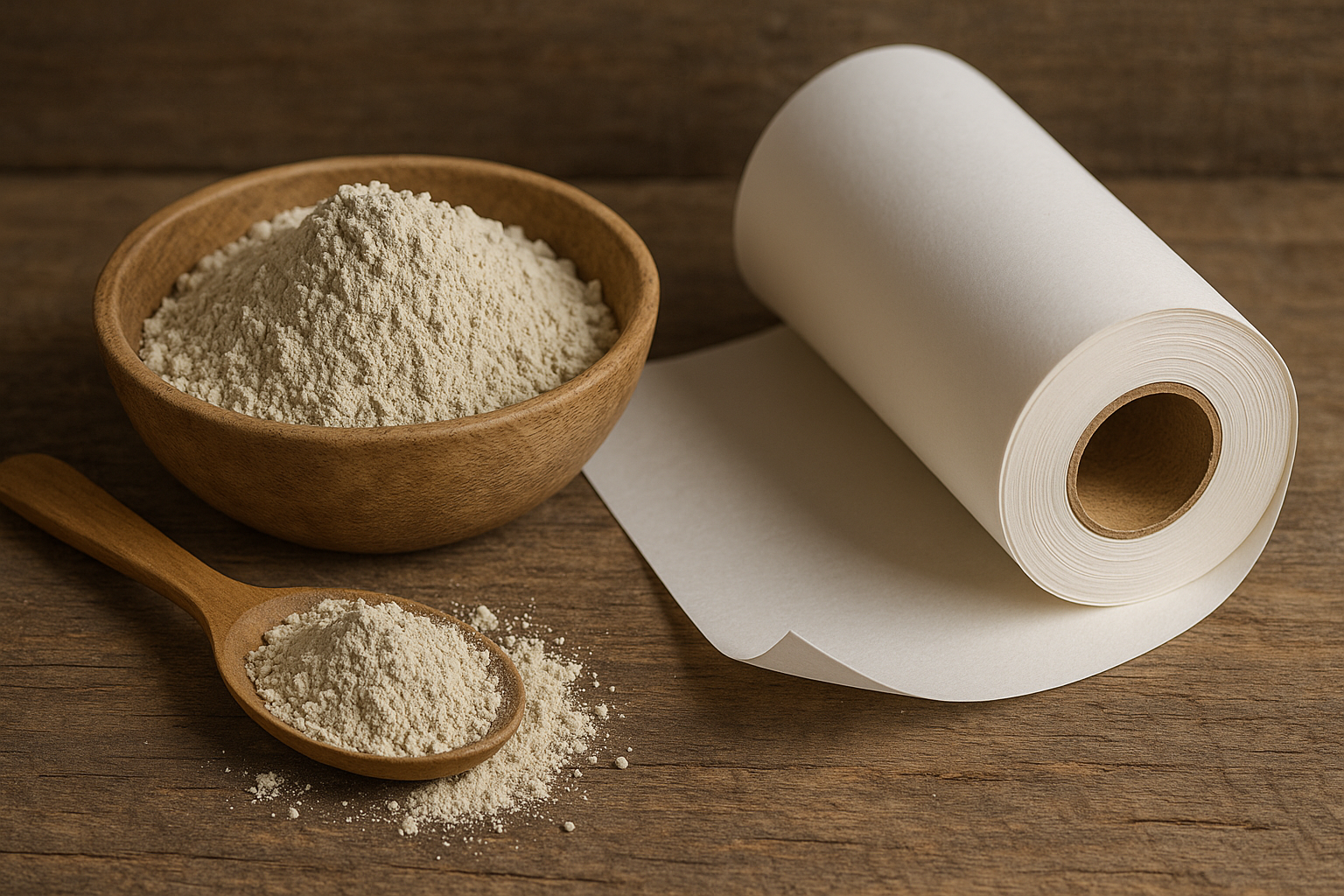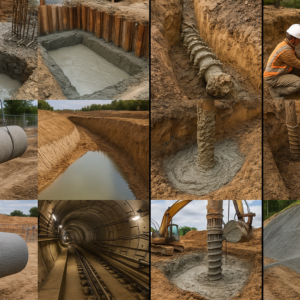Paper bentonite plays a silent yet powerful role in the paper manufacturing process. This natural clay mineral helps papermakers produce higher-quality products while keeping machines running smoothly. Let’s break it down and explore why this material has become so valuable to the paper industry.
Understanding Paper Bentonite
Paper bentonite is a specially processed form of sodium montmorillonite clay. This natural mineral forms from volcanic ash deposits over millions of years. When added to water, it swells to many times its original volume and creates a gel-like substance with unique adsorption properties.
The paper industry uses this specific grade of bentonite because of its high cation exchange capacity. This means the clay particles can attract and hold onto various substances that would otherwise cause problems during paper production. Manufacturers carefully select and process bentonite to meet the demanding requirements of modern papermaking operations.
What makes paper bentonite special is its extremely large surface area relative to its weight. Each tiny particle provides extensive contact area for capturing unwanted materials. This characteristic, combined with its natural swelling ability, makes it perfect for the wet-end chemistry of paper machines.
Primary Paper Bentonite Uses in Manufacturing
Pitch Control and Resin Absorption
Wood resins tend to obstruct machines during paper production, creating one of the most persistent challenges in papermaking. These sticky substances, commonly called “pitch,” come from the natural resins in wood pulp. When pitch builds up on equipment, it causes downtime, maintenance issues, and quality defects in the final product.
Bentonite helps control pitch by adsorbing and immobilizing these substances, preventing them from depositing on paper machinery. The clay particles act like microscopic sponges, capturing resin droplets before they can accumulate on rollers, screens, and felts. This absorption happens at the molecular level, where the bentonite’s charged surface attracts and binds the pitch components.
Mills that process wood with high resin content particularly benefit from paper bentonite. By adding it at strategic points in the process, operators can maintain cleaner machine circuits and reduce costly shutdowns for cleaning.
Filler Retention and Paper Quality
Paper contains more than just wood fibers. Manufacturers add various fillers like calcium carbonate, titanium dioxide, and kaolin clay to improve opacity, brightness, and printability. Getting these fillers to stay in the paper sheet rather than washing away with the water represents a significant challenge.
Bentonite improves retention properties and helps hold fibers and fillers together. When combined with synthetic retention aids like polyacrylamide, bentonite creates a dual-polymer system that dramatically improves how much filler remains in the finished paper. This means less waste, lower material costs, and better paper properties.
The retention system also affects how fast water drains from the paper web. Better retention leads to improved drainage, which allows machines to run faster and produce more paper per hour. This operational benefit directly impacts the mill’s productivity.
Contamination Control in Recycling
Paper recycling has grown tremendously, but recycled pulp brings its own set of challenges. Adhesives, inks, coatings, and other contaminants must be removed to produce quality recycled paper. Bentonite supports the adsorption of contaminants during waste paper recycling.
During the de-inking process, bentonite helps capture sticky materials that would otherwise redeposit on fibers or equipment. It helps avoid agglomerations of sticky constituents, keeping them dispersed so they can be washed away. This makes the entire recycling process more effective and allows mills to use higher percentages of recycled fiber.
CMS Industries supplies paper-grade bentonite that meets the specific requirements of recycling operations, where consistency and purity matter for optimal performance.
Machine Cleanliness and Efficiency
Clean papermaking machines run better. Bentonite prevents sticky deposits resulting in cleaner machine circuits. By continuously removing pitch, dissolved wood components, and other troublesome materials, bentonite acts as a maintenance aid that works around the clock.
Cleaner machines mean fewer breaks, less downtime for washing, and more consistent paper quality. The water loops in paper machines recirculate many times, and without bentonite, contaminants would build up quickly. This continuous cleaning action helps mills maintain stable operations even when processing variable raw materials.
Wondering which bentonite products are trending for skincare in 2025? Read this blog to discover the latest beauty must-haves!
How Paper Bentonite Works in the Wet End
The wet end of a paper machine is where pulp, water, and additives come together to form paper. Bentonite improves wet-end processing through several mechanisms working simultaneously.
When added to the pulp slurry, bentonite particles disperse throughout the mixture. Their negative surface charge attracts positively charged substances like some types of pitch and dissolved resins. The high surface area provides countless sites for these materials to attach.
At the same time, bentonite interacts with cationic polymers added for retention. Together, they form micro-flocs that trap fillers and fine fibers. These flocs are large enough to stay in the paper sheet but small enough not to create visible lumps or weak spots.
The swelling property of paper bentonite also plays a role. As it absorbs water and expands, it creates a gel structure that helps stabilize the entire wet-end system. This contributes to more consistent sheet formation and fewer quality problems.
Benefits That Matter to Papermakers
Reduced Operating Costs
Every time a paper machine stops for cleaning, money is lost. Labor costs for maintenance, lost production time, and chemical costs for washing all add up. By preventing pitch deposits and keeping machines cleaner, paper bentonite reduces these expensive interruptions.
Material costs also drop when retention improves. More of the expensive fillers and fibers stay in the paper instead of washing into the wastewater. Over a year, this can represent significant savings.
Better Product Quality
Papers made with proper bentonite usage tend to have fewer defects like spots, holes, and dirt specks. The finished product shows better formation, more uniform opacity, and improved printing characteristics. These quality improvements can justify premium pricing or open up new market opportunities.
Environmental Benefits
Water consumption in paper mills is substantial. Bentonite helps improve loop water treatment, which reduces water consumption. When mills can reuse more of their process water, they discharge less wastewater and draw less fresh water from the environment.
Better retention also means less fiber and filler loss to effluent streams, reducing the environmental load from papermaking operations.
Application Methods and Dosage
Paper mills typically add bentonite at specific points where it will be most effective. Common addition points include:
- The pulper or refiner where stock preparation begins
- Before pressure screens to capture pitch before filtration
- In combination with retention aids at the headbox
Dosage rates vary widely depending on the type of paper being made, the raw materials used, and specific machine conditions. Mills might use anywhere from 0.5 to 5 kilograms of bentonite per ton of paper produced. Technical service from suppliers like CMS Industries helps mills determine the optimal amount and addition point.
The bentonite usually comes as a fine powder that must be dispersed in water before addition. Proper mixing is critical to achieve full performance. Some mills prepare bentonite slurries in advance, while others use inline mixing systems.
Different Grades for Different Needs
Not all paper bentonite is identical. Manufacturers offer different grades tailored to specific applications:
- Standard Paper Grade: This general-purpose grade works well for pitch control and basic retention improvement. It provides good value for many common papermaking situations.
- High-Purity Grades: Papers that require exceptional brightness or cleanliness need bentonite with minimal iron and other impurities. These premium grades cost more but deliver superior results for specialty papers.
- Acid-Activated Bentonite: Some recycling applications and carbonless copy paper production benefit from acid-treated bentonite with enhanced adsorption properties for certain contaminants.
CMS Industries manufactures multiple grades of bentonite to serve different segments of the paper industry, from newsprint to fine writing papers.
Working with Cationic Polymers
Modern paper mills rarely use bentonite alone. Paper-grade bentonite works well with high and low molecular weight polyacrylamide. This combination, called a dual-polymer or microparticle retention system, delivers better results than either component alone.
The typical approach involves adding a high-molecular-weight cationic polymer first, followed quickly by bentonite. The polymer helps form initial bonds between fibers and fillers, while the bentonite reinforces these bonds and adds its own adsorption capability. This creates a synergistic effect where the total benefit exceeds what each chemical could achieve separately.
Getting the dosage ratio and timing right requires expertise. Mill technical teams work with suppliers to fine-tune these systems for maximum performance and cost-effectiveness.
Selecting the Right Bentonite Supplier
Quality and consistency matter when choosing paper bentonite. The clay must meet tight specifications for particle size, purity, cation exchange capacity, and swelling properties. Variations in these properties can affect paper machine performance and product quality.
Reliable suppliers like CMS Industries invest in quality control systems to ensure every shipment meets specifications. They maintain consistent mining and processing methods to minimize batch-to-batch variation. Technical support is another consideration. Good suppliers provide application expertise to help mills get the most value from their bentonite program.
Location and logistics also affect supplier choice. CMS Industries benefits from strategic manufacturing locations near world-class ports, ensuring reliable delivery to customers across the globe.
Future Trends in Paper Bentonite Applications
The paper industry continues to evolve, creating new opportunities for bentonite:
- Increased Recycled Content: As sustainability drives higher recycled fiber usage, the need for effective contamination control grows. Paper bentonite will play an expanding role in enabling mills to use more recycled content without sacrificing quality.
- Water Conservation: Tightening environmental regulations and water scarcity push mills to close their water loops. Bentonite’s ability to control contaminants in recycled white water becomes increasingly valuable.
- Specialty Papers: The growth of specialty and packaging papers with demanding specifications creates opportunities for high-performance bentonite grades tailored to these applications.
- Process Optimization: Advanced process control and data analytics help mills optimize bentonite usage for maximum benefit at minimum cost.
Connect with Quality Bentonite Solutions
Choosing the right paper bentonite and optimizing its application can significantly impact your mill’s performance, product quality, and operating costs. If you are looking for consistent, high-quality bentonite backed by technical expertise, CMS Industries offers a range of paper-grade products designed to meet the demanding requirements of modern papermaking.
With ISO 9001:2015 certification, strategic manufacturing locations, and a commitment to customer success, CMS Industries stands ready to support your papermaking operations. Contact CMS Industries today to discuss how our bentonite solutions can benefit your specific application and help you achieve your production and quality goals.
Frequently Asked Questions
What is the main purpose of paper bentonite in papermaking?
Paper bentonite primarily controls pitch by absorbing wood resins that would otherwise deposit on machinery and create operational problems. It also improves filler retention, keeping more of the added materials in the finished paper rather than losing them to wastewater. These functions help maintain cleaner machines, reduce costs, and improve paper quality throughout the manufacturing process.
How much paper bentonite should be used per ton of paper?
The dosage typically ranges from 0.5 to 5 kilograms per ton of paper produced, depending on several factors. The specific amount needed varies based on the type of paper being made, the raw materials used, machine conditions, and whether bentonite is used with other retention chemicals. Mills should work with technical experts to determine the optimal dosage for their particular situation.
Can paper bentonite be used with recycled pulp?
Yes, paper bentonite works exceptionally well with recycled pulp. It helps remove contaminants like adhesives, inks, and coatings that come with recycled fiber. The bentonite captures these sticky materials during de-inking operations, preventing them from redepositing on fibers or equipment. This makes it possible to use higher percentages of recycled content while maintaining good paper quality.
What is the difference between paper bentonite and other bentonite types?
Paper bentonite is a specially processed sodium montmorillonite with high cation exchange capacity and purity standards that meet papermaking requirements. Other bentonite types, like those used for drilling or cat litter, may have different particle sizes, mineral compositions, or impurity levels. Paper-grade bentonite must not introduce contaminants or affect paper brightness, making it more refined than bentonite for other applications.
How does bentonite improve paper machine efficiency?
Bentonite improves efficiency by preventing pitch deposits that cause machine shutdowns for cleaning. It keeps the machine circuits cleaner, reducing downtime and maintenance labor. Better filler retention means materials stay in the paper instead of washing away, reducing raw material costs. Improved drainage allows faster machine speeds. Together, these benefits increase production while lowering operating costs per ton of paper produced.







